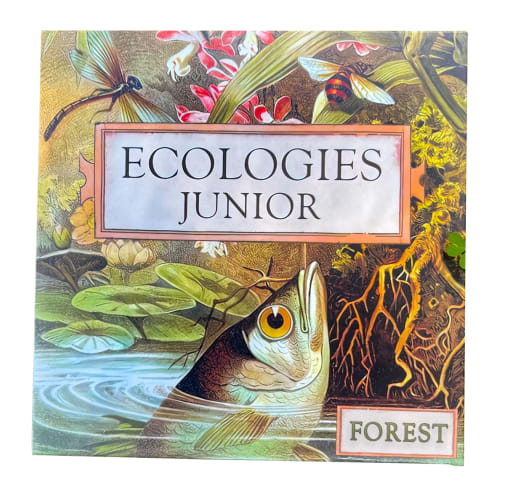This version of Ecologies is aimed towards children and can be played two different ways. The game includes 64 forest-themed tiles with a picture of an animal or plant on each, as well as the name of the animal or plant, and a food web coding system. There are 2 of each card, allowing players to either play a beginner version of ecologies with a food chain in place, or to just play a traditional memory game with the game cards. The cards have a sturdy, cardboard feel and have a square shape, which is great for memory games. ~ Brianna
Ecologies Junior: Forest Game
Product Overview
- 64 sturdy, double-sided forest-themed cards
- Great activity for reviewing forest food webs
- Beautiful, full-color graphics
- Can be played competitively or cooperatively
Description
A simplified and accessible version of our Ecologies game, "Ecologies Junior: Forest" allows younger children to practice building food webs with 64 sturdy tiles.
- There are 32 pairs of matching organism tiles for a total of 64 tiles.
- The game can be played as a simple memory game with children flipping tiles or extended to include food web building and trophic level practice.
- It is flexible enough to be played cooperatively or competitively, depending on the audience.
- It contains much of the art from the original Ecologies card game, with a few bonus additions as well.
Designed by a biology teacher, it can be played for fun or used in preschools, outdoor schools, homeschools, and elementary schools to teach children about forest ecology.
It's a dog-eat-dog world in Ecologies – well, actually, it's a dog-eat-rat world, ecologically speaking! The goal of this delightfully educational game is to create sustainable ecosystems across environments such as Desert, Grassland, and Ocean. Beautifully illustrated cards serve as these Biomes, as well as the Plants and Animals within them. Players take turns drawing and playing cards to create balanced ecologies. For instance, a healthy temperate forest ecology contains blackberries (producing plant), bees (to feed on the blackberries), frogs (to eat the bees), hawks (to eat the frogs), and earthworms (to decompose everything). Once a biome is complete, it offers bonuses ranging from points, to extra cards, to sabotaging another player's ecosystem. The trick is that players can only play cards "up" the food chain, and players are limited to a small handful of cards, often leaving half-finished ecosystems worth very few points. To alleviate this danger, players are encouraged to make trades – sometimes asymmetrical – with their competitors. It's not uncommon for players to offer up a fistful of unusable animals in exchange for the one missing link they need to complete their ecosystem! Adding another element of unpredictability are powerful Biotic and Abiotic Factor cards, providing bonuses to oneself or inflicting setbacks upon opponents. With gorgeous John James Audubon-style artwork, open gameplay, and vocabulary and animal diet information galore, this game is equally at home as a science supplement or a family game. For 1-6 players, with a playing time of 30-60 minutes. Each edition contains all-new biomes, animals, and Biotic and Abiotic factor cards, and can be played standalone or mixed with the original game.
| Product Format: | Other |
|---|---|
| Grades: | PK-4 |
| Brand: | Montrose Biology |
| EAN/UPC: | 0086000321774 |
| Length in Inches: | 5.625 |
| Width in Inches: | 5.625 |
| Height in Inches: | 1.625 |
| Weight in Pounds: | 1.2 |

